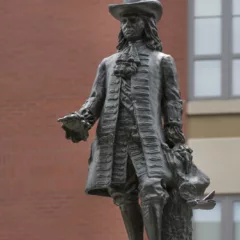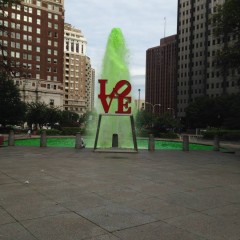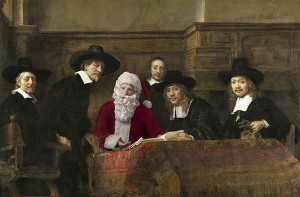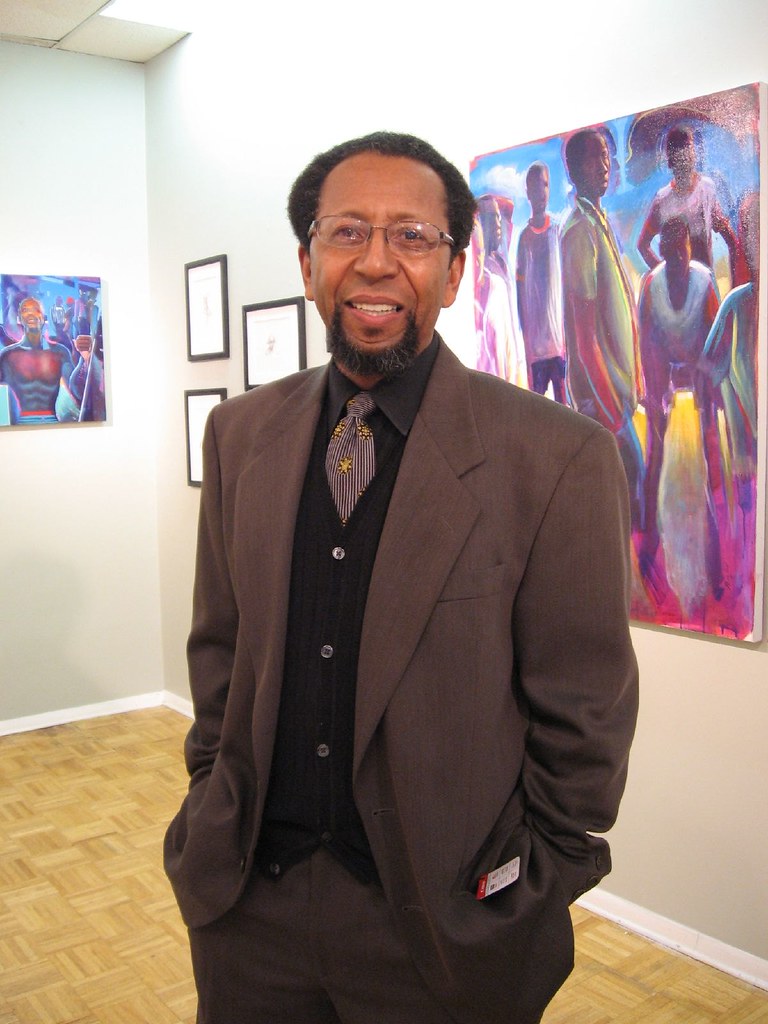
James Dupree, standing in front of two paintings by Pheoris West, made during West’s residency at the Dupree Studios Residency Program.
At this moment when utopian thinking and art activism is on our minds, I had a talk with James Dupree and Pheoris West (pronunciation Fee-OR-iss) about their exhibit, Collaboration: Pheoris West and James Dupree, at Dupree’s gallery and about the Dupree Studios Residency Program that West just completed as the inaugural participant.
What? The Dupree Studios Residency Program? Well, that’s part of what I want to tell you about.
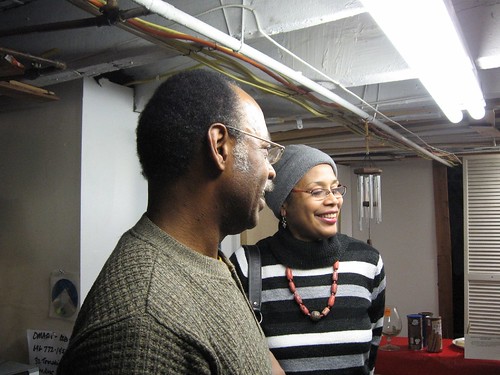
Pheoris West standing with his wife Michelle.
Both Dupree and West went to the Pennsylvania Academy of the Fine Arts in the 70s, after which West went on for an MFA at Yale, and Dupree an MFA at Penn. Their paths more or less parted until recently. At their recent meeting, Dupree put into action an idea he had been mulling over since 2002.
Roberta and I first met Dupree when we split with him a huge storefront window on Walnut Street for the Artfront Partnership in 1994. His half was an installation about jazz.
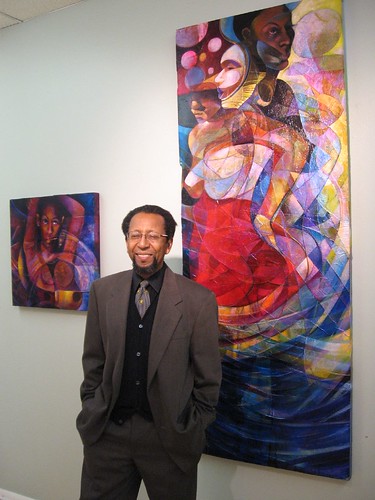
James Dupree and his paintings Niya #2(left) and #1 (right)
By then, Dupree had a well-established place in the Philadelphia art scene, with his jazz- and African-art-inspired approach to painting and his connection to the city’s African-American art community. A major mural of his graces Mother Bethel Church; he’s in collections from the Philadelphia Museum of Art to PAFA to SmithKline Beecham and Tower Records.
West is a professor of art at Ohio State. His work has appeared in numerous art venues, including the Boston Museum and the Studio Museum in Harlem. Besides curing Homage to Jazz in 1999 at the Martin Luther King Center in Columbus, he served on the National Endowment of the Arts Expansion Arts Panel, the International Juror National Exhibition of Zimbabwe, and the Ohio Arts Council.
The two artists agreed to talk to me before the opening of their joint exhibit on Saturday. They had plenty to say–about art theories, socialism and community, making things happen for yourself, and race and class in art and in their lives.
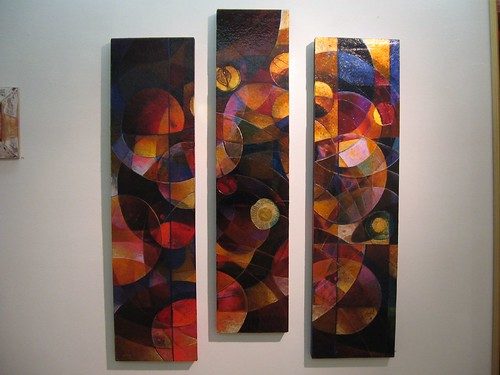
Dupree began talking before West arrived. Here’s a summary of what he had to say:
Pheoris’ work in the ’70s was a big influence on him–painting women, using multiple faces. “I didn’t realize how much the work influenced me. No matter what the race is, every woman is a woman. We have to get over this [obsession with differences in skin color]. There’s kinship in the palette.”
At this point, West arrived, and both said they were influenced by jazz, among other things.
West: I’m not a jazz musician. James plays the keyboards. But both my brothers played in jazz bands.
There have to be some principles that apply to all the arts. [While painting] I would remember things my brothers said [about music] and say to myself, Oh, that’s what they mean, about issues of rhythm, issues of repetition, issues of spaces.
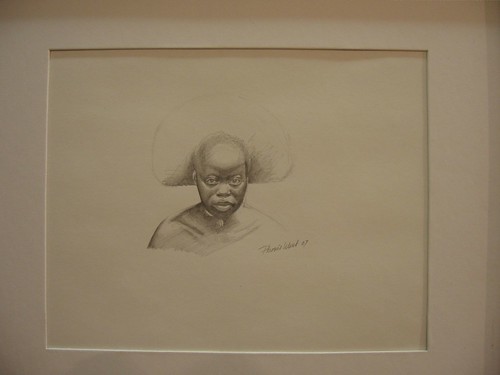
Pheoris West, Shona (face) 10 x 8 inches, graphite on paper, on of series of 5 graphite drawings.
Libby: How was it, surviving as a student at the Academy?
West: It was the Vietnam war. The issues of survival had taken a toll by time I reached 20. I basically lost my entire class. The ones that went to college were the only ones who survived. Each year, I was given a gift. Art school, that was…heaven to me.
Dupree: Our age group wasn’t supposed to live past 21.
West: Merit scholarships were being provided [African American and poor students for the first time]. Those barriers fell away. …We weren’t supposed to make it past one year [i.e. not measure up].
Libby: Where was the show in Ohio?
Dupree: Kiaca Gallery in Columbus, Ohio. I contacted Pheoris to come down. I found out he played golf and that was really it.
I was trying to create a situation where the artist can come and find solitude to work. That’s what my studio is. I also arrange, tried to arrange, other things for him. He did a lecture at the Academy that was incredible.
West: …I wish it was me [who had come up with the residency]. When James asked, I said, I’m going to get there and I’m going to be a part of it, no matter what.
Libby: What inspired you, James?
Dupree: Haystack [in 2002] changed my life. It was a socialist environment. Everyone had a job, and everyone was there because they wanted to be there. Everybody was smiling. They had good food, off the charts.
It was an incredible faculty. Everyone was famous but me. [But everyone embraced him and his work, and a couple of people recognized it from applications he had sent to Anderson Ranch and to the University of Arizona]. People see you freshly there [away from Philadelphia], with none of the crap, and I knew that from going to Europe.
I couldn’t get a summer program going. It was too complicated. So I said, I’m going to do a small version [of Haystack]. Bill Strickland did it in Pittsburgh. He started with just a rowhouse. All we needed was to get one class going.
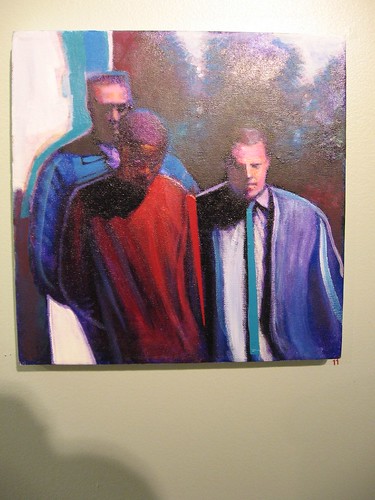
Pheoris West,The Keepers of the Gate (Vibration Series) 46 x 48″, acrylic on canvas, one of several works in the exhibit inspired by the Jena 5 situation.
West: If we make this happen, the world will be a better place.
…Sometimes collaboration is making something important happen, believing in it. What does the next generation of artists need, maybe that socialistic quality of things.
James markets his own work. He has made a life out of marking his own work. And he is enabling others to share.
I didn’t necessarily have the money, but I have a kind of status, some earned, some unearned. James says it’s your coming that brings credibility to this program. Then, no problem, I’m coming. We started to believe ourselves capable of living a life of us thinking. Making artwork, one starts thinking through the medium.
Libby: How has the residency changed your painting?

Almost Kiss (Vibration Series), 43 x 72 inches, acrylic on canvas
West: I could make as many mistakes as I wanted to. I didn’t have to explain it to anybody. I don’t care if this next mark teaches my students anything.
When I’m at school, I think, I’ve got to put two strong hours into this meeting. I’ve got to put two strong hours into the studio. [But, during the residency], I don’t have to have two strong hours. I can have 10. They can be weak hours. The strong hours don’t make the art better.
Everybody can put a boat in the water and take it out, but it’s not like going out in a boat, putting your feet up, and going with the waves. That’s special.
I know the experience of being involved with the work that way. It’s like a drug, but it’s legal. And the experience of painting is one of surrender rather than making something happen.
[From here, West went on to talk about hermeticism and the presence of the hermetic principle of vibration in his work and multiples moving back and forth. Here’s a bit from wikipedia that seems relevant:
In the Hermetic belief system, all is in the mind of The All. Hermeticism acknowledges that there exist many gods, but that these deities, along with all other beings, exist within, and are created by, The ALL.
…Everybody and Everything in the universe is part of this entity. As everything is mental, it is also a vibration. All vibrations vibrate from the densest of physical particles, through mental states, to the highest spiritual vibrations. In Hermeticism, the only difference between different states of physical matter, mentality, and spirituality is the frequency of their vibration. The higher the vibration, the further it is from base matter.]
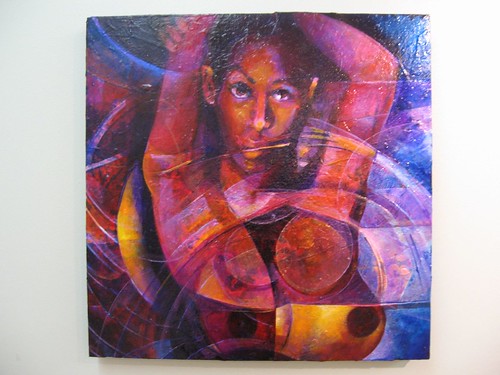
James Dupree, Niya #2 (there’s a sequin giving a glint to the right eye)
Libby: I want to ask you about a comment you made earlier about different classes of art.
West: Classical, comics, graffiti, event art, Modernism, these are just styles.
It is possible to have quality without style. Style is something people apply [to art], and people at different stages [of understanding and experience] respond. We as artists understand what’s difficult to do, difficult to make, and it’s not isolated to any group, age or style. The style itself is not good or bad. Only the complexity of what you’re doing with that artwork that matters. You have to be ready for it. There’s no real caste system.
…
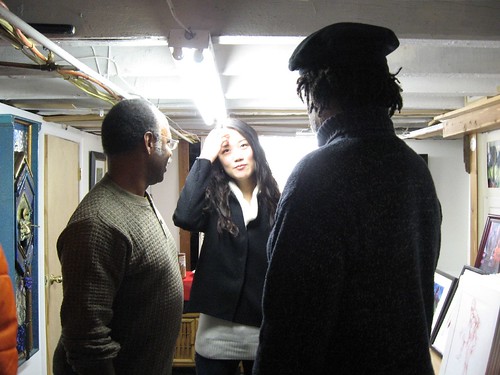
The party begins with West to the left, an unidentified young woman, and artist James Brantley, who has a show up now at Sande Webster Gallery.
We stopped our conversation when people began arriving for the opening, including Sande Webster and James Brantley, Barbara Bullock, and Tanya Dodd. Upstairs, Dupree’s wife Anita held court, but the food and the artists were downstairs, and so that’s where the action was.
Collaboration includes more than 50 works of art, about half by Dupree, half by West. The exhibit runs through the month of December, with a closing reception New Year’s Eve, 7 p.m. to midnight.


